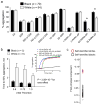Racial differences in human platelet PAR4 reactivity reflect expression of PCTP and miR-376c
- PMID: 24216752
- PMCID: PMC3855898
- DOI: 10.1038/nm.3385
Racial differences in human platelet PAR4 reactivity reflect expression of PCTP and miR-376c
Abstract
Racial differences in the pathophysiology of atherothrombosis are poorly understood. We explored the function and transcriptome of platelets in healthy black (n = 70) and white (n = 84) subjects. Platelet aggregation and calcium mobilization induced by the PAR4 thrombin receptor were significantly greater in black subjects. Numerous differentially expressed RNAs were associated with both race and PAR4 reactivity, including PCTP (encoding phosphatidylcholine transfer protein), and platelets from black subjects expressed higher levels of PC-TP protein. PC-TP inhibition or depletion blocked PAR4- but not PAR1-mediated activation of platelets and megakaryocytic cell lines. miR-376c levels were differentially expressed by race and PAR4 reactivity and were inversely correlated with PCTP mRNA levels, PC-TP protein levels and PAR4 reactivity. miR-376c regulated the expression of PC-TP in human megakaryocytes. A disproportionately high number of microRNAs that were differentially expressed by race and PAR4 reactivity, including miR-376c, are encoded in the DLK1-DIO3 locus and were expressed at lower levels in platelets from black subjects. These results suggest that PC-TP contributes to the racial difference in PAR4-mediated platelet activation, indicate a genomic contribution to platelet function that differs by race and emphasize a need to consider the effects of race when developing anti-thrombotic drugs.
Figures





References
-
- Libby P. Mechanisms of acute coronary syndromes and their implications for therapy. The New England journal of medicine. 2013;368:2004–2013. - PubMed
-
- Leger AJ, Covic L, Kuliopulos A. Protease-activated receptors in cardiovascular diseases. Circulation. 2006;114:1070–1077. - PubMed
-
- Abrams CS, Brass LF. Platelet Signal Transduction. In: Colman RW, Hirsh J, Marder VJ, Clowes AW, George JN, editors. Hemostasis and thrombosis: basic principles and clinical practice. Lippincott Williams & Wilkins; Philadelphia, PA: 2006. pp. 617–629.
-
- Macfarlane SR, Seatter MJ, Kanke T, Hunter GD, Plevin R. Proteinase-activated receptors. Pharmacol Rev. 2001;53:245–282. - PubMed
-
- Lova P, et al. Contribution of protease-activated receptors 1 and 4 and glycoprotein Ib-IX-V in the G(i)-independent activation of platelet Rap1B by thrombin. The Journal of biological chemistry. 2004;279:25299–25306. - PubMed
Publication types
MeSH terms
Substances
Associated data
- Actions
Grants and funding
LinkOut - more resources
Full Text Sources
Other Literature Sources
Medical
Molecular Biology Databases

